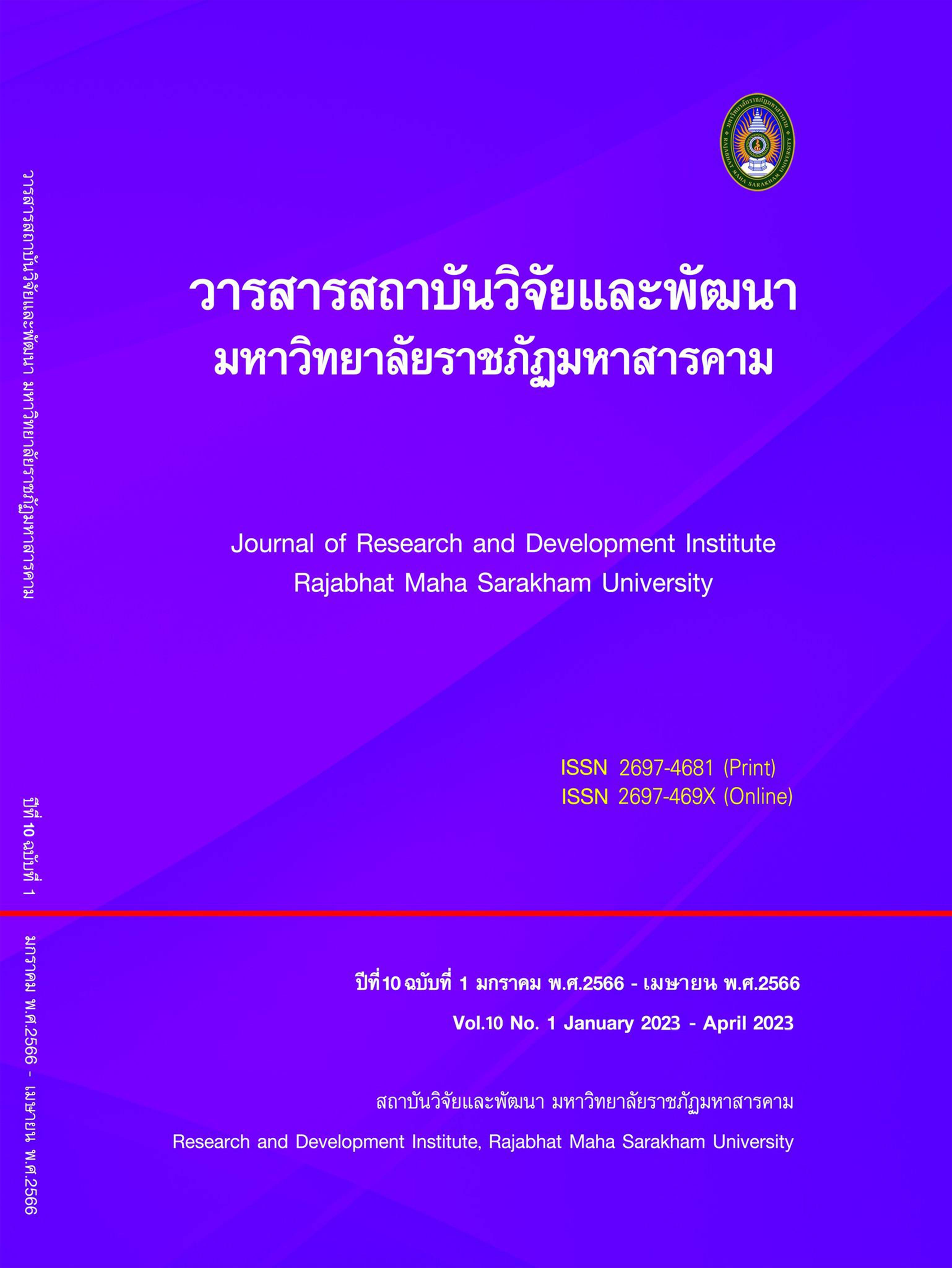ผลการติดเทปแบบยืดหยุ่นบริเวณข้อเท้าที่มีต่อประสิทธิภาพในการเตะเฉียงและ การทรงตัวขณะเคลื่อนที่ของนักกีฬาเทควันโดระดับเยาวชน
คำสำคัญ:
Elastic Tape, Ankle, Round Kick, Dynamics Balance, Taekwondoบทคัดย่อ
การศึกษานี้มีวัตถุประสงค์เพื่อศึกษาและเปรียบเทียบผลของการติดเทปแบบยืดหยุ่นที่ข้อเท้าที่มีต่อการทรงตัวขณะเคลื่อนที่ และประสิทธิภาพในการเตะเฉียงของนักกีฬาเทควันโดระดับเยาวชน ซึ่งกลุ่มตัวอย่างเป็นอาสาสมัครจากชมรมเทควันโดจังหวัดปัตตานีจำนวน 18 คน ที่สมัครเข้าร่วมในการศึกษาครั้งนี้ โดยทุกคนจะผ่านการคัดกรองตามเงื่อนไขดังนี้ มีอายุระหว่าง 12 -15 ปี, สุขภาพแข็งแรง ไม่มีอาการบาดเจ็บที่ข้อเท้า, ไม่มีอาการแพ้ต่อเทปที่ใช้งาน ทั้งนี้อาสาสมัครทุกคนที่ผ่านการคัดกรอง จะได้รับการสุ่มเข้ากลุ่ม(Random Assignment) กลุ่มละ 9 คน โดยแบ่งออกเป็นกลุ่มทดลองที่ได้รับการติดเทปยืดหยุ่นที่ข้อเท้า และกลุ่มควบคุมที่ไม่ได้รับการติดเทป ต่อจากนั้นอาสาสมัครทั้งสองกลุ่มจะทำการทดสอบการทรงตัวแบบเคลื่อนที่โดยใช้การทดสอบ Star Excursion Balance Test; SEBT จากนั้นทดสอบความสามารถในการเตะเฉียง แล้วแยกกลุ่มตัวอย่างทั้งสองให้ไปพักในพื้นที่รับรอง ต่อจากนั้นจะทำการสุ่มกลุ่มเพื่อติดเทปและทดสอบ ภายหลังการทดสอบเสร็จสิ้นนักวิจัยใช้การทดสอบ Man – Whitney วิเคราะห์ผลและเปรียบเทียบระหว่างกลุ่มติดเทปยืดหยุ่นกับกลุ่มที่ไม่ติดเทป
ผลการวิจัยพบว่า ก่อนการติดเทปการทรงตัวขณะเคลื่อนที่ และประสิทธิภาพในการเตะเฉียง ไม่มีความแตกต่างกันทางสถิติ ทั้งนี้ภายหลังการติดเทป กลุ่มทดลองที่ติดเทปแบบยืดหยุ่นมีความสามารถในการเตะเฉียงซ้ำ และการเตะเฉียงสูงดีกว่ากลุ่มควบคุมที่ไม่ได้ติดเทปอย่างมีนัยสำคัญทางสถิติที่ระดับ 0.05 ในด้านการทรงตัวขณะเคลื่อนที่พบว่าภายหลังการติดเทปกลุ่มทดลองที่ติดเทปแบบยืดหยุ่น มีการทรงตัวแบบเคลื่อนที่ดีกว่ากลุ่มควบคุมที่ไม่ได้ติดเทปอย่างมีนัยสำคัญทางสถิติที่ระดับ 0.05 สถิติใน 7 ทิศทาง ได้แก่ anterior, anteromedial, medial, posteromedial, posterior, posterolateral และlateral ในขณะที่ทิศทาง anterolateral ไม่พบความแตกต่างอย่างมีนัยสำคัญทางสถิติที่ระดับ ดังนั้นในการศึกษาเบื้องต้นนี้แสดงให้ทราบถึงผลของการใช้เทปแบบยืดหยุ่นที่ข้อเท้าช่วยปรับปรุงความสามารถในการเตะเฉียงซ้ำและการเตะสูง รวมถึงมีผลต่อการควบคุมทรงตัวขณะเคลื่อนที่บางทิศทางในนักกีฬาเทควันโดระดับเยาวชน
เอกสารอ้างอิง
Asghar Akbari, Alireza Sarmadi, Parisa Zafardanesh. (2014). “The effect of ankle taping and balance exercises on postural stability indices in healthy women”. Journal of Physical Therapy Science. 26 (5):763-769.
Butler RJ, Southers C, Paul PG, Kyle BK, Phillip JP. (2012). “Differences in soccer players’ dynamic balance across levels of competition”. Journal Athletic Training. 47(6): 616-620.
Chang HY, Chou KY, Lin JJ, Lin CF, Wang CH. (2010). “Immediate effect of forearm Kinesio taping on maximal grip strength and force sense in healthy collegiate athletes”. Phys Ther Sport. 11(4): 122–127.
Estevan I, Falco C. (2013). “Mechanical analysis of the roundhouse kick according to
height and distance in taekwondo”. Biol Sport. 30(4):275-279
Ferrari FJ CM, De Ru E, Abdi E, Boyer FC, Trenchard H,Taiar R. (2015). “Does kinesio-taping influence dynamic standing Balance”. IJSMR,2:1-10.
Fong SSM, Cheung CKY, et al. (2012). “Sport-specific balance ability in Taekwondo practitioners”. J Hum Sport Exercise. 7: 520-526.
Hrysomallis C.(2011). “Balance ability and athletic performance”. Sport Med.41: 221-232.
Jay H, Rebecca AB, Sheri AH, Lauren COK. (2006). “Simplifying the Star Excursion Balance Test: Analyses of Subjects with and without Chronic Ankle Instability”. Journal of Orthopedic & Sports Physical Therapy. 36(3) :131-137
Kazemi M, Perri G, Soave D. (2010). “A profile of 2008 Olympic Taekwondo competitors”. The Journal of the Canadian Chiropractic Association. 54(4): 243–249.
Kim BJ, Lee JH, Kim CT, Lee SM. (2015). “Effects of ankle balance taping with kinesiology tape for a patient with chronic ankle instability”. Journal of Physical Therapy Science, 27(7): 2405-2406.
Kocahan T, Balcı A, Akınoğlu B. (2020). “An Investigation of Acute Effect of Kinesio Taping on Single Leg Balance in Taekwondo Athletes: A Randomized Controlled Trial”. Turk J Physiother Rehabil. 31(1): 29-35.
Moreira PV, Goethel MF, Goncalves M. (2016). “Neuromuscular performance of Bandal Chagui: Comparison of sub elite and elite taekwondo athletes”. Journal of Electromyography and Kinesiology.30(10):55-65.
Murray H, Husk L.(2001). “Effect of kinesio taping on proprioception in the ankle”. J Orthop Sports Phys Ther. 31(1):A–37.
Myers TW. (2009). Anatomy trains: Myofascial meridians for manual and movement therapists. 2nd ed. Edinburgh: Churchill Livingstone.
Noh Zulfikri, Justine Maria.(2017). “Effects of Kinesio Taping on Dynamic Balance Following Fatigue: a Randomized Controlled Trial”. DOI: 10.1298/ptr.E9887
Nunes, G. S., de Noronha, M., Cunha, H. S., Ruschel, C., & Borges, N. G., Jr. (2013). “Effect of kinesio taping on jumping and balance in athletes: A crossover randomized controlled trial”. Journal of Strength and Conditioning Research/National Strength & Conditioning Association. 27(11): 3183-3189.
Pablo Valdes-Badilla, Mauricio Barramuno Medina, et.al.(2018). “Differences in the electromyography activity of a roundhouse kick between novice and advanced taekwondo athletes”. Journal of Martial Arts Anthropology. 18(1): 31–38.
Purves D, Augustine GJ, Fitzpatrick D, et al. (2004). Neuroscience. 3nd edition. Sinauer Associates: Sunderland (MA) U.S.A.
Wilson, V., Douris, P., Fukuroku, T., Kuzniewski, M., Dias, J., & Figueiredo, P. (2016). “The immediate and long-term effects of kinesiotape(R) on balance and functional performance”. International Journal of Sports Physical Therapy. 11(2): 247-253.
ดาวน์โหลด
เผยแพร่แล้ว
รูปแบบการอ้างอิง
ฉบับ
ประเภทบทความ
สัญญาอนุญาต
ลิขสิทธิ์ (c) 2023 ภิญโญ โชติรัตน์, วิชัย อึงพินิจพงศ์

อนุญาตภายใต้เงื่อนไข Creative Commons Attribution-NonCommercial-NoDerivatives 4.0 International License.
บทความที่ได้รับการตีพิมพ์เป็นลิขสิทธิ์เป็นของผู้ประพันธ์บทความ







